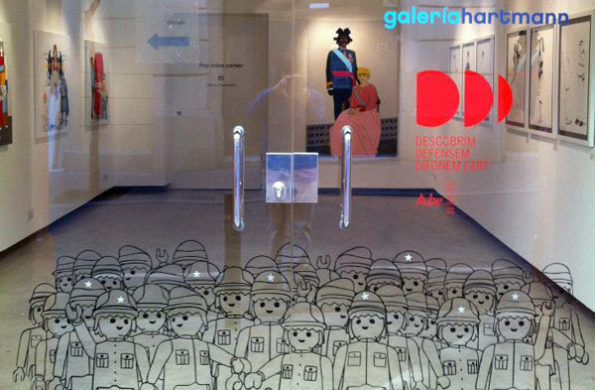Search
To search for an exact match, type the word or phrase you want in quotation marks.
A*DESK has been offering since 2002 contents about criticism and contemporary art. A*DESK has become consolidated thanks to all those who have believed in the project, all those who have followed us, debating, participating and collaborating. Many people have collaborated with A*DESK, and continue to do so. Their efforts, knowledge and belief in the project are what make it grow internationally. At A*DESK we have also generated work for over one hundred professionals in culture, from small collaborations with reviews and classes, to more prolonged and intense collaborations.
At A*DESK we believe in the need for free and universal access to culture and knowledge. We want to carry on being independent, remaining open to more ideas and opinions. If you believe in A*DESK, we need your backing to be able to continue. You can now participate in the project by supporting it. You can choose how much you want to contribute to the project.
You can decide how much you want to bring to the project.

In a context of image and speed, painting keeps going despite its repeatedly announced death. To question the role of painting, also means analysing who controls the current imaginary, how we mix past and present and which economic desires appear amidst the brush-marks.
Héctor Francesch picks up the threads of Art History (with capital letters): Picasso, royal portraits, Velázquez and Pop art, with Warhol and Basquiat. Alongside he incorporates a cast of anonymous characters of urban fauna, such as graffiti artists, rock stars and cleaning ladies, as well as celebrities from popular culture, from Frankenstein, Lola Flores and SpongeBob, to the Clicks of Playmobil. All reflecting an aesthetic that is close to advertising and the world of comics, but in a totally conventional medium, oil on canvas. The result is more suggestive of an invasion of the pictorial space by advertising, than an exhibition of painted canvases. This lack of discretion ought to respond to something more than a mere whim, normally. However, if we talk of contemporary figures – real and fictional – portrayed in paint and hanging on the wall of a gallery, the question becomes a little more complicated, particularly by relating them to characters and features pertaining to art history. The question is what are we dealing with here?
At first glance, this melange of registers, the glorified past of art history and the everyday banality of the present, isn’t actually very shocking. The first impulse is to think of advertising, searching for the cult meaning and the brand that it endeavours to allude to. Instead of actual icons, we see brands and references to leisure and fashion. At no point do we stop and consider that, like Justice or the eagle – iconographic elements omnipresent ad infinitum in public buildings across the world– these icons could conceal their very own allegorical features specific to the world today. Even though we are dealing with Homer Simpson, it could define or allude to an aspect of life, as we know it today, without necessarily being a tool in the hands of copywriters in an advertising agency, in their drive to sell us yet more things.
We accept that the iconography of past masters can be Art while at the same time be used as an image within advertising and the media. The works of Picasso, Velázquez, Warhol and even Basquiat, enjoy this double meaning. Depending on the context, these icons, as happens with emblematic images such as the Mona Lisa, can be a display of grand master paintings, or a capitalist and distorted allusion to a brand, or even an allegory disguised as an advertising joke. This indiscriminate use of icons from the past as canon fodder for advertising campaigns is nowadays no longer shocking.
However, this double existence is reserved only for those that can already be considered as pertaining to the past. Current icons are limited to advertising purposes, incapable of demonstrating their worth as elements of works of art. Contemporary society rarely looks to painting to capture the images that define it. In the exhibition space, the art of painting is only an acceptable guest if it is an abstract expression within a conceptual framework, usually reserved to spaces of the white cube. Far from being a figurative painting that plays with registers and represents society. Perhaps the only true example would be the painting of pop culture, the kingdom of Warhol and Basquiat. Even today any attempt to try and do the same is immediately qualified as the appropriation of a past technique and aesthetic, in some way devaluing the work that has been created, which impedes the birth of an independent and contemporary style.
Another part of the problem is that for years now those responsible for gathering together and capturing social and cultural icons have been the media. They control the diffusion and creation of the iconographic references that our society produces. The iconography that was previously presented by the canvases of great painters, engraved on our subconscious, has been transferred, adopted, mutilated and integrated by force into a consumer culture, even on a visual level, being incessantly reproduced anywhere it can be printed or projected.
The same happens with the anonymous characters of contemporary society. They are not usually the subjects of art, unless portrayed by a camera lens. Policemen, cleaning ladies, and even soldiers, are not figures that painting tends to reflect upon. The responsibility for creating an inventory of reality, if done in a realistic manner, has been granted to photography. But if the portrait isn’t realistic we find ourselves once again back in the world of advertising.
The works by Francesch, as a result of his obvious nerve in contradicting the current artistic trend, open up, however small it might be, a terrain for painting. In his paintings, the pictorial art presents itself as a mode of expression and support for the iconography of our time. In each piece we discover the influences that have marked the life of the artist, ones which half of us also share. Together they represent his vision of society today, synthesised into figures with clearly defined outlines and brilliant colours. However, although the exhibition is subject to this global concept, each painting stands on its own, avoiding being a mere illustration. With cutting irony and layer upon layer of meaning, full of strange encounters and unusual reunions, they urge one to revise the current state of the world, but always with a touch of humour.
Each one of the paintings presupposes a visualization of what we see in the streets and the media every day, questions that define and question the value of life in the 21st century. Revisions of old masters such as “Un Rincón Familiar” (A Familiar Corner), where Dora Maar, Picasso’s muse, shows us her living room, full of allusions to the culture of cannabis and a strange portrait of Frankenstein. Or “Mentira Cochina”(Big Fat Lie), which unites a voluptuous Demoiselle d’ Avignon with a somewhat obscene Pinocchio. Satirical royal portraits, substituted by the Lords of pop culture, Warhol and Basquiat, complete with blond wig. Winks at Barcelona culture and its street beer vendors – a veritable icon among the city’s night owls -, in “Una de Paqui”, that shows the allegorical power of contemporary elements. A sort of homage to graffiti and urban art, with “La Clase de graffiti” (The Graffiti Lesson), where the “old bill” contemplates a “yob” while he carefully draws Dona Maar in Picasso’s cubist style, showing how spray-paint artists are just that, artists…
Francesch focuses on contemporary life with humour, making it somewhat easier to digest and analyse. Free of the negative weight that is often generated by the cover of a newspaper, here they are shown as tools for laughter and entertainment, while at the same time helping us to comprehend the malformations that our visual culture has created. The result is a portrait of the present, codified by a mixture of symbolism and consumerism, where the characters stop being brands to become allegories that conform the reality that surrounds us.
If we really stop and think about it, the strange encounters between these characters, such as in the “Vieja friendo huevos” (Old woman frying eggs) where Homer Simpson appears with a chef’s hat beside the figure from Velázquez, are not so far from reality. In a visual culture where anything can be manipulated to remove or add a certain meaning, where tradition is mixed up with trends, and where allegory always passes through television before taking on its own meaning, it ends up being almost normal that Donald Duck knows the Click of Playmobil. And though it might be a bit of an exaggeration, Lola Flores, as the super heroine, could become pure contemporary myth. This ends up being even more plausible, if we consider that idolatry has shifted to the icons of pop and mass culture. In fact, if traditional portraiture were the work of painters, they would be charged with creating the portraits of this power. It would reflect all the gender stereotypes: the typical pose of a pair of monarchs, the attributes that allude to their power and identity. Perhaps the result would not be exactly the same as the portrait of Basquiat and Warhol, but it would undoubtedly be very similar.
According to many, the role of art today should be to offer the spectator with a point of view. Perhaps, to achieve this, revealing what is bad in the world and condemning it are not the only available routes. Perhaps it is helpful to show what the world is like in its entirety, including the most banal aspects of contemporary culture, the really definitive ones. Maybe capturing these supposedly visual aberrations with humour is a very effective way of depicting the world in which we live to stimulate critical thought amongst the public. Be it as it may, Héctor Francesch reminds us of a possibility: the place that painting could have in our society.

Verónica Escobar Monsalve is a restless soul, with a digital nature and an analogue heart. Her investigations centre on art and culture that mix the digital world with pre-digital thought. Art and culture that is capable of reflecting the complexity of today’s world. She believes in the vital importance of a critical spirit and how this can be applied to any facet in life, however difficult it may be.
"A desk is a dangerous place from which to watch the world" (John Le Carré)